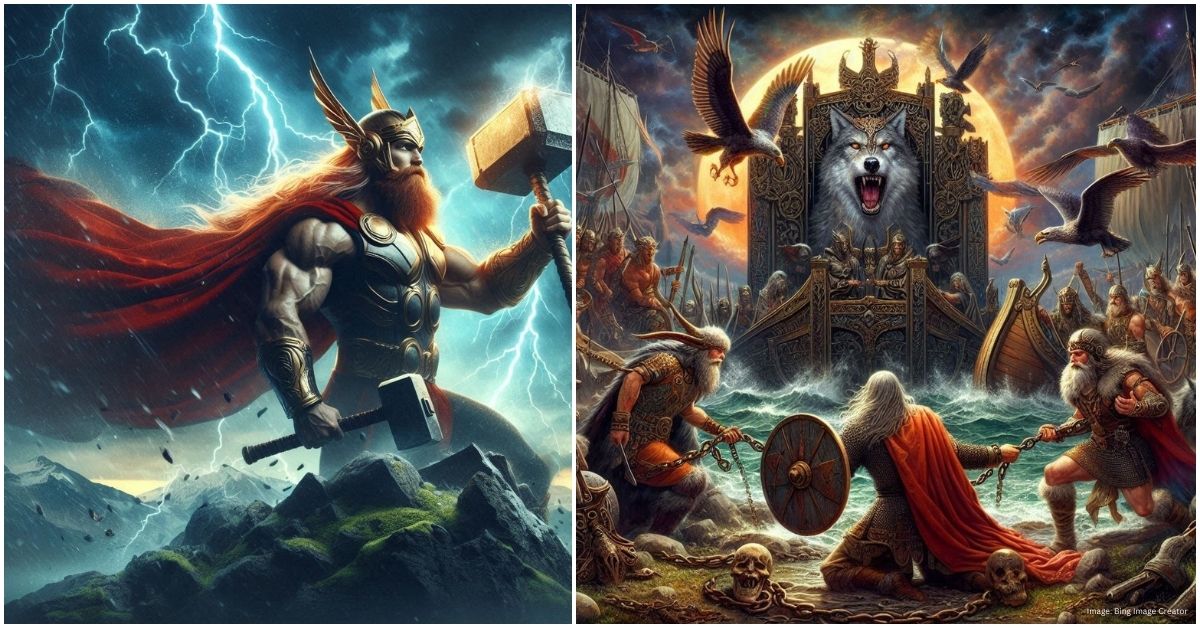Ragnarok, often referred to as the “Twilight of the Gods,” is one of the most dramatic and significant events in Norse mythology. It represents the end of the cosmos, a cataclysmic series of events that leads to the destruction of the world as it is known. However, it is not just an end but also a new beginning, a theme that resonates through the ancient myths of the Norse people.
The Prophesied Events Leading to Ragnarok
The story of Ragnarok begins with prophecies that foretell a time of great strife and suffering. These prophecies are found in the ancient texts of the Poetic Edda and the Prose Edda, which describe a world descending into chaos. The signs of the coming apocalypse are numerous:
- Fimbulwinter: A harsh and unrelenting winter, lasting for three years, known as Fimbulwinter, will grip the earth. This period of cold and darkness will cause widespread famine and suffering, weakening the world in preparation for the final battle.
- The Breaking of Bonds: The great wolf Fenrir, bound by the gods to prevent his destructive power, will break free from his chains. Alongside him, Loki, the trickster god, will escape his imprisonment, leading an army of giants and the dead against the gods.
- The Serpent and the Wolf: Jormungandr, the Midgard Serpent, will rise from the ocean, causing massive tidal waves that engulf the land. Fenrir, now free, will devour the sun, plunging the world into eternal darkness.
The Final Battle
The culmination of Ragnarok is the final battle between the gods, the forces of chaos, and the giants. This battle is fought on the plains of Vigrid, where the fate of the world will be decided.
- Odin vs. Fenrir: The Allfather Odin, leader of the Aesir gods, will face Fenrir, the monstrous wolf. Despite his strength and wisdom, Odin will fall to Fenrir, who will devour him.
- Thor vs. Jormungandr: Thor, the god of thunder, will battle his arch-enemy Jormungandr. The two are destined to kill each other, with Thor striking the serpent down with his mighty hammer, Mjolnir, but only after being poisoned by its venom.
- Loki vs. Heimdall: Loki, the god of mischief, will confront Heimdall, the guardian of the Bifrost, the rainbow bridge. The two will engage in a fierce duel, resulting in mutual destruction.
As the gods and their enemies perish, the world itself will be consumed by fire, sinking into the sea. Mountains will crumble, and the sky will darken as the cosmos collapses.
The Aftermath: A New Beginning
While Ragnarok is a tale of destruction, it also holds a message of renewal. After the world has been destroyed, a new earth will rise from the sea, fresh and green. The surviving gods, including Odin’s sons Vidar and Vali, along with Thor’s sons Modi and Magni, will gather in the aftermath to rebuild. Two human survivors, Lif and Lifthrasir, will emerge from the shelter of Yggdrasil, the world tree, to repopulate the earth.
Symbolism and Legacy of Ragnarok
Ragnarok in Norse mythology serves as a profound reflection on the cyclical nature of life, death, and rebirth. It embodies the inevitable end of all things but also the hope of a new beginning. This duality is central to the Norse worldview, where even in the face of doom, there is a glimmer of renewal.
The story of Ragnarok has transcended its mythological origins to influence modern literature, art, and popular culture. It has inspired countless interpretations, from epic novels to blockbuster films, all of which explore the themes of apocalypse and rebirth in various ways.
Conclusion
Ragnarok is more than just a myth; it is a powerful narrative that encapsulates the Norse understanding of the world and its cycles. It is a story of heroes and villains, of courage in the face of certain doom, and of the eternal hope for a new dawn after the darkest of nights. Through the tale of Ragnarok, we glimpse the ancient Norse perspective on the cosmos—a perspective that, while rooted in the past, continues to resonate with audiences today.


